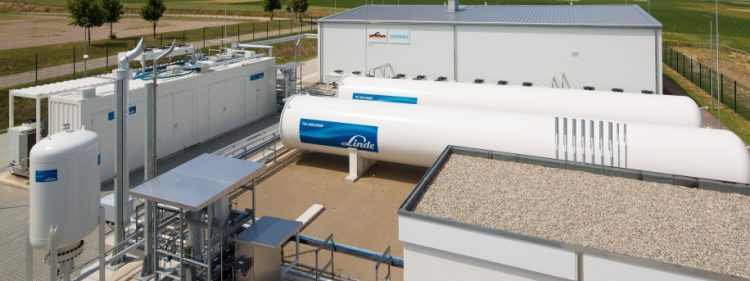World’s Largest Hydrogen Electrolysis Facility

Siemens and its partners have officially commissioned the world’s largest hydrogen electrolysis facility with a capacity of up to six megawatts.
PEM stands for polymer electrolyte membrane, and describes a process designed to generate hydrogen using water and electricity. Part of a two-year research project, the facility’s partners are Siemens, RheinMain University, Linde, and the Mainz (Germany) municipal utilities.
The Mainz facility has sufficient capacity to deal with bottlenecks in the power network and power surges from small wind farms. It produces hydrogen using electricity that is largely sourced from nearby wind turbines. Hydrogen that is generated using renewable energy can be added to the gas network as an energy storage medium, or used for industrial processes, or supplied to fuel cell-powered vehicles.
Flexible Facility
Siemens supplied the core of the facility, which consists of the electrolysis systems, which are equipped with Simatic controls.
In addition, Siemens provided medium voltage stations with GEAFOL transformators, which supply the low and high voltage supply units of the Sinamic converters and a gas-insulated medium voltage switchboard (20kV). The overall control system of the Energy Farm is also Simatic based.
It is maintained by Linde which is also responsible for purifying, condensing, storing and filling the hydrogen. RheinMain University is providing scientific supervision. The project analyzes the interaction of all components, for example between electrolysis and compressor or the coupling with the power and the gas networks.
Within the electrolyzer – unlike the conventional method, which uses alkaline electrolysis – a proton-conducting membrane (PEM) creates a partition between the two electrodes where oxygen and hydrogen are separated.
The result is that the new PEM electrolyzer provides a highly dynamic response within milliseconds and can briefly cope with 1.5 times its power rating, which means it can deal with excess power production without difficulty even if there is a spike in generation.
Perfect Energy Source
Hydrogen’s versatility is a major advantage. It can be converted back into electricity, it can power vehicles, or be methanized – a process in which hydrogen (H2) reacts with CO2 to produce methane, the main component in natural gas. In this way, energy can be stored in existing natural gas infrastructures and used for heating or powering vehicles.
Hydrogen is more than just a perfect energy source. It is also an important raw material for the chemical industry. But today, it is obtained almost entirely from natural gas. A superior alternative, however, would be to produce hydrogen from renewable electricity at a cost that would be competitive with using natural gas.
At that point, hydrogen could form a veritable “dream team” in conjunction with the greenhouse gas carbon dioxide. Here, the basic concept is that carbon monoxide (CO), an important intermediate product in the chemical industry, is obtained from fossil energy sources. Instead, however, it could also be generated from CO2 and H2, producing water as a byproduct. This reaction takes place using special catalyzers that Bayer is developing in collaboration with partners in the scientific world. Another catalyzer could also produce formic acid, which is another important basic substance in organic chemistry. Norbert Aschenbrenner
Mr. Dr Norbert Aschenbrenner
Editorial Office
Siemens AG
norbert.aschenbrenner@siemens.com
Mr. Florian Martini
Journalist Inquieries
Siemens AG
florian.martini@siemens.com
Media Contact
All latest news from the category: Power and Electrical Engineering
This topic covers issues related to energy generation, conversion, transportation and consumption and how the industry is addressing the challenge of energy efficiency in general.
innovations-report provides in-depth and informative reports and articles on subjects ranging from wind energy, fuel cell technology, solar energy, geothermal energy, petroleum, gas, nuclear engineering, alternative energy and energy efficiency to fusion, hydrogen and superconductor technologies.
Newest articles

Combatting disruptive ‘noise’ in quantum communication
In a significant milestone for quantum communication technology, an experiment has demonstrated how networks can be leveraged to combat disruptive ‘noise’ in quantum communications. The international effort led by researchers…

Stretchable quantum dot display
Intrinsically stretchable quantum dot-based light-emitting diodes achieved record-breaking performance. A team of South Korean scientists led by Professor KIM Dae-Hyeong of the Center for Nanoparticle Research within the Institute for…

Internet can achieve quantum speed with light saved as sound
Researchers at the University of Copenhagen’s Niels Bohr Institute have developed a new way to create quantum memory: A small drum can store data sent with light in its sonic…





















